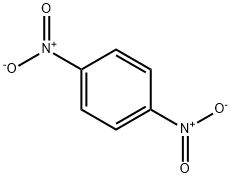
1,4-Динитробензол
- английское имя1,4-DINITROBENZENE
- CAS №100-25-4
- CBNumberCB3152579
- ФормулаC6H4N2O4
- мольный вес168.11
- EINECS202-833-7
- номер MDLMFCD00007314
- файл Mol100-25-4.mol
| Температура плавления | 170-173 °C(lit.) |
| Температура кипения | 183.4 °C34 mm Hg(lit.) |
| плотность | 1.625 g/mL at 25 °C(lit.) |
| давление пара | 2.25 x 10-4 mmHg at 35 °C (Hine et al., 1963) |
| показатель преломления | 1.725 (589.3 nm) |
| Fp | 150 °C |
| температура хранения | Store below +30°C. |
| растворимость | alcohol: soluble1g in 300ml |
| форма | Crystals or Powder |
| цвет | Ochre to orange |
| Растворимость в воде | Soluble in water. (0.8 g/L) at 20°C. |
| Мерк | 14,3273 |
| БРН | 1105828 |
| констант закона Генри | 4.79(x 10-7 atm?m3/mol) at 35 °C (approximate - calculated from water solubility and vapor pressure) |
| Пределы воздействия | NIOSH REL: TWA 1, IDLH 50; OSHA PEL: TWA 1 ACGIH TLV: TWA 0.15 ppm for all isomers (adopted). |
| Стабильность | Stable, but may be shock-sensitive. May explode if heated. Incompatible with oxidizing agents, strong bases, nitric acid, many metals, tin oxides. |
| Справочник по базе данных CAS | 100-25-4(CAS DataBase Reference) |
| Рейтинг продуктов питания EWG | 1-2 |
| FDA UNII | 784Q9O56S9 |
| Предложение 65 Список | p-Dinitrobenzene |
| Система регистрации веществ EPA | p-Dinitrobenzene (100-25-4) |
| UNSPSC Code | 12352102 |
| NACRES | NA.22 |
| Коды опасности | T+,N,T,F | |||||||||
| Заявления о рисках | 26/27/28-33-34-50/53-52/53-39/23/24/25-23/24/25-11 | |||||||||
| Заявления о безопасности | 28-36/37-45-60-61-16 | |||||||||
| РИДАДР | UN 3443 6.1/PG 2 | |||||||||
| OEB | C | |||||||||
| OEL | TWA: 1 mg/m3 [skin] | |||||||||
| WGK Германия | 3 | |||||||||
| RTECS | CZ7525000 | |||||||||
| TSCA | Yes | |||||||||
| Класс опасности | 6.1 | |||||||||
| Группа упаковки | II | |||||||||
| кода HS | 29042090 | |||||||||
| Банк данных об опасных веществах | 100-25-4(Hazardous Substances Data) | |||||||||
| Токсичность | IC50 (24-h) for river bacteria 1.27 mg/L (Yuan and Lang, 1997). | |||||||||
| NFPA 704: |
|
рисовальное письмо(GHS)
-
рисовальное письмо(GHS)



-
сигнальный язык
опасность
-
вредная бумага
H300+H310+H330:Смертельно при проглатывании, при контакте с кожей или при вдыхании.
H410:Чрезвычайно токсично для водных организмов с долгосрочными последствиями.
H373:Может поражать органы (Нервная система) в результате многократного или продолжительного воздействия при вдыхании.
-
оператор предупредительных мер
P262:Избегать попадания в глаза, на кожу или одежду.
P264:После работы тщательно вымыть кожу.
P273:Избегать попадания в окружающую среду.
P280:Использовать перчатки/ средства защиты глаз/ лица.
P302+P352+P310:ПРИ ПОПАДАНИИ НА КОЖУ: Промыть большим количеством воды. Немедленно обратиться за медицинской помощью.
P304+P340+P310:ПРИ ВДЫХАНИИ: Свежий воздух, покой. Немедленно обратиться за медицинской помощью.
1,4-Динитробензол химические свойства, назначение, производство
Химические свойства
light yellow powderФизические свойства
Clear, colorless to white crystalline solid or monoclinic crystals. Slowly turns yellow on exposure to air.Использование
1,4-Dinitrobenzene is used in a study to evaluate the ionization mechanism and solvent effect by novel atmospheric pressure photoionization mass spectrometry in negative ion mode for analysis of some compounds. 1,4-Dinitrobenzene can be used in synthesis of dyes and dye intermediates.Определение
ChEBI: A dinitrobenzene carrying nitro groups at positions 1 and 4.Общее описание
Colorless to yellow solid. Sinks and mixes slowly with water.Реакции воздуха и воды
Slowly mixes with water.Профиль реактивности
All three isomers have similar properties and may react vigorously with oxidizing materials. Their reaction with nitric acid (nitration) will lead to a mixture of trinitrobenzenes possessing high-explosive properties [Urbanski, 1967, vol. 3, p. 290]. If heat and reaction conditions of the nitration are not controlled, detonation comparable to TNT may occur [Anon., J. R. Inst. Chem., 1960, 84, p. 451]. Mixture of 1,3-dinitrobenzene with tetranitromethane was found highly explosive [Urbanski, 1964, vol. 1, 592]. 1,2-dinitrobenzene is a severe explosion hazard when shocked or exposed to heat or flame. When heated to decomposition all dinitrobenzens emit toxic fumes of nitrogen oxides [Sax, 9th ed., 1996, p. 1374].Угроза здоровью
INHALATION OR INGESTION: Headache, vertigo, nausea, vomiting, diarrhea, fever, rapid weak pulse, decreased blood pressure, cyanosis, exhaustion, hepatomegaly, jaundice, albuminurea, hematuria, visual scotomata, amblyopia and nystagmus. EYES: Irritation. SKIN: Stains skin yellow; if skin contact is prolonged, can be absorbed into blood causing same symptoms as for inhalation.Профиль безопасности
Suspected carcinogen. Poison by ingestion. Mutation data reported. Mxture with nitric acid is a high explosive. When heated to decomposition it emits toxic fumes of NOx. See also 0and mDINITROBENZENEЭкологическая судьба
Biological. In activated sludge inoculum, following a 20-d adaptation period, no biodegradation was observed (Pitter, 1976).Photolytic. Low et al. (1991) reported that the nitro-containing compounds (e.g., 2,4- dinitrophenol) undergo degradation by UV light in the presence of titanium dioxide yielding ammonium, carbonate, and nitrate ions. By analogy, 1,4-dinitrobenzene should degrade forming identical ions.
Chemical/Physical. Releases toxic nitrogen oxides when heated to decomposition (Sax and Lewis, 1987). 1,4-Dinitrobenzene will not hydrolyze in water (Kollig, 1993).
Методы очистки
Crystallise 1,4-dinitrobenzene from EtOH or EtOAc. Dry it under vacuum over P2O5. It can be sublimed in a vacuum. [Beilstein 5 IV 741.]1,4-Динитробензол запасные части и сырье
1,4-Динитробензол поставщик
| поставщик | телефон | страна | номенклатура продукции | благоприятные условия |
|---|---|---|---|---|
| +86-021-021-50872116 +8613122107989 |
China | 10035 | 58 | |
| +8618950047208 | China | 43416 | 58 | |
| 400-1166-196 18981987031 |
China | 11707 | 57 | |
| 400-1166-196 13458535857 |
China | 13350 | 58 | |
| 400-1166-196 18502815961 |
China | 14603 | 60 | |
| 13810281473 | CHINA | 511 | 58 | |
| 4008-099-669 | CHINA | 73043 | 58 | |
| 58896805 | CHINA | 15620 | 58 | |
| 13051508530 | CHINA | 3187 | 58 | |
| 18153089275 | China | 22695 | 58 |